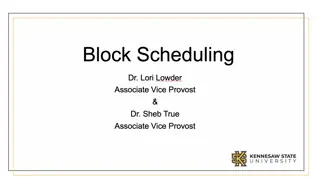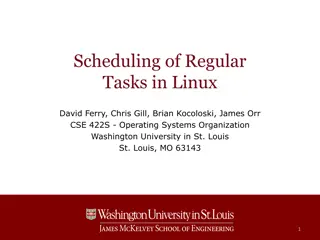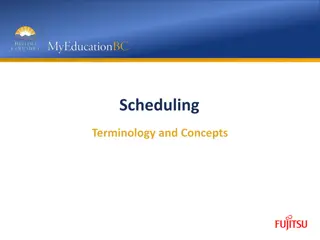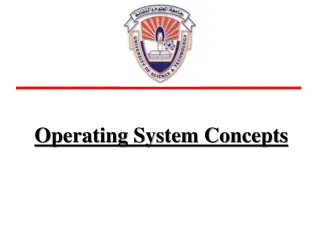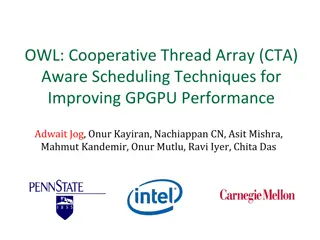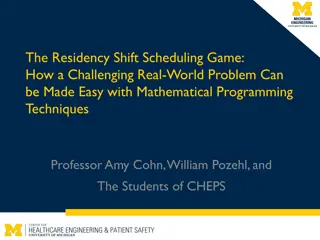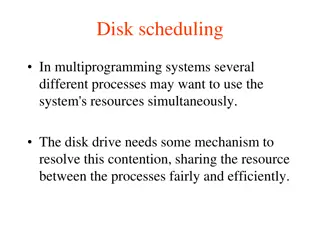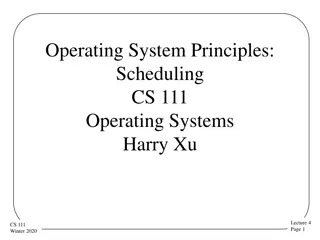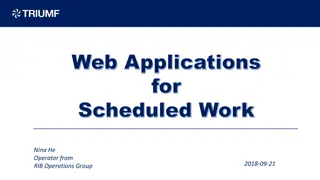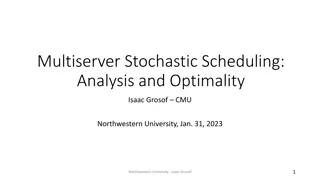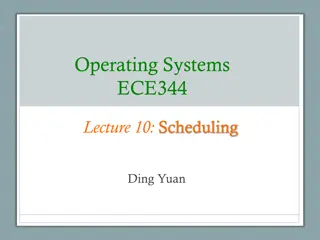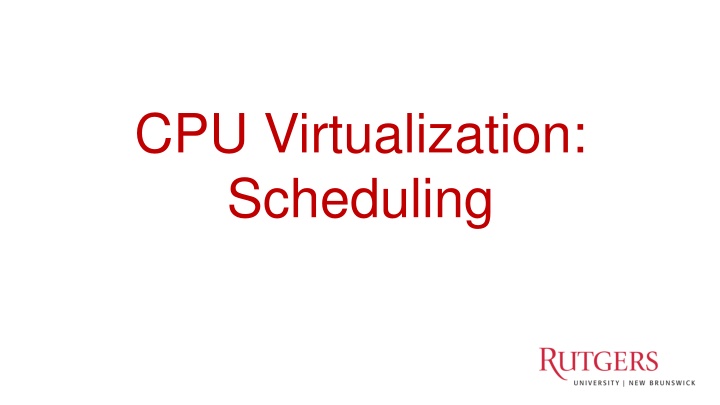
CPU Virtualization, Process Creation, and Scheduling in Operating Systems
Explore the intricate processes of CPU virtualization, different methods of process creation, and various scheduling policies in operating systems. Learn about key concepts such as cloning processes, scheduling algorithms like FCFS and SJF, and the crucial role of the dispatcher in context switching.
Download Presentation

Please find below an Image/Link to download the presentation.
The content on the website is provided AS IS for your information and personal use only. It may not be sold, licensed, or shared on other websites without obtaining consent from the author. If you encounter any issues during the download, it is possible that the publisher has removed the file from their server.
You are allowed to download the files provided on this website for personal or commercial use, subject to the condition that they are used lawfully. All files are the property of their respective owners.
The content on the website is provided AS IS for your information and personal use only. It may not be sold, licensed, or shared on other websites without obtaining consent from the author.
E N D
Presentation Transcript
CPU Virtualization: Scheduling
Process Creation Two ways to create a process Build a new empty process from scratch Copy an existing process and change it appropriately Option 1: New process from scratch Steps Load specified code and data into memory; Create empty call stack Create and initialize PCB (make it look like context-switch) Put process on ready list Advantages: No wasted work (compared to option 2) Disadvantages: Difficult to express all possible options for setup, complex Process permissions, where to write I/O, environment variables Example: WindowsNT has call with 10 arguments
Process Creation Option 2: Clone an existing process and change it Example: Unix fork() and exec() Fork(): Clones the calling process Exec(char *file): Overlays file image on calling process Fork() Stop current process and save its state Make copy of code, data, stack, and PCB Add new PCB to ready list Any changes needed to child process? Yes! Exec(char *file) Replace current data and code segments with those in specified file Advantages: Flexible, clean, simple Disadvantages: Wasteful to perform copy and then overwrite of memory
Unix Process Creation Fork/exec crucial to how the user s shell is implemented! While (1) { Char *cmd = getcmd(); Int retval = fork(); If (retval == 0) { // This is the child process // Setup the child s process environment here // E.g., where is standard I/O, how to handle signals? exec(cmd); // exec does not return if it succeeds printf( ERROR: Could not execute %s\n , cmd); exit(1); } else { // This is the parent process; Wait for child to finish int pid = retval; wait(pid); } }
Scheduling Questions answered in this lecture: What are different scheduling policies, such as: FCFS, SJF, STCF, RR and MLFQ? What type of workload performs well with each scheduler? What scheduler does Linux currently use? https://en.wikipedia.org/wiki/Completely_Fair_Scheduler https://developer.ibm.com/tutorials/l-completely-fair-scheduler/ Chapters 7-10 Disclaimer: Materials derived, reused, and modified from OSTEP book and lectures of Prof. Andrea and Remzi Arpaci-Dusseau and Prof. Yojip Won
CPU Virtualization: Two Components Dispatcher (Previous lecture) Low-level mechanism Performs context-switch Switch from user mode to kernel mode Save execution state (registers) of old process in k-stack, PCB Insert PCB in ready queue Load state of next process from k-stack, PCB to registers Switch from kernel to user mode Jump to instruction in new user process Scheduler (Today) Policy to determine which process gets CPU when
Review: Process State Transitions Descheduled Running Ready Scheduled I/O: initiate I/O: done Blocked How to transition? ( mechanism ) When to transition? ( policy )
Vocabulary Workload: set of job descriptions (arrival time, run_time) Job: View as current CPU burst of a process Process alternates between CPU and I/O process moves between ready and blocked queues Scheduler: logic that decides which ready job to run Metric: measurement of quality of schedule
Scheduling Performance Metrics Minimize turnaround time Do not want to wait long for job to complete Completion_time arrival_time Minimize response time Schedule interactive jobs promptly so users see output quickly Initial_schedule_time arrival_time Maximize throughput Want many jobs to complete per unit of time Maximize resource utilization Keep expensive devices busy Minimize overhead Reduce number of context switches Maximize fairness All jobs get same amount of CPU over some time interval
Workload Assumptions 1. Each job runs for the same amount of time 2. All jobs arrive at the same time 3. All jobs only use the CPU (no I/O) 4. Run-time of each job is known
Scheduling Basics Workloads: Schedulers: FIFO SJF STCF RR Metrics: turnaround_time response_time arrival_time run_time
Example: workload, scheduler, metric JOB arrival_time (s) run_time (s) A ~0 10 B ~0 10 C ~0 10 FIFO: First In, First Out - also called FCFS (first come first served) - run jobs in arrival_time order What is our turnaround? completion_time - arrival_time
FIFO: Event Trace Time 0 0 0 0 10 10 20 20 30 Event A arrives B arrives C arrives run A complete A run B complete B run C complete C JOB arrival_time (s) run_time (s) A ~0 10 B ~0 10 C ~0 10
FIFO (Identical JOBS) A B C JOB arrival_time (s) run_time (s) A ~0 10 B ~0 10 C ~0 10 0 20 40 60 80 Gantt chart: Illustrates how jobs are scheduled over time on a CPU
FIFO (IDENTICAL JOBS) [A,B,C arrive] A B C 0 20 40 60 80 What is the average turnaround time? Def: turnaround_time = completion_time - arrival_time
FIFO (IDENTICAL Jobs) A: 10s B: 20s C: 30s 0 20 40 60 80 What is the average turnaround time? Def: turnaround_time = completion_time - arrival_time (10 + 20 + 30) / 3 = 20s
Scheduling Basics Workloads: Schedulers: FIFO SJF STCF RR Metrics: turnaround_time response_time arrival_time run_time
Workload Assumptions 1. Each job runs for the same amount of time 2. All jobs arrive at the same time 3. All jobs only use the CPU (no I/O) 4. The run-time of each job is known
Any Problematic Workloads for FIFO? Workload: ? Scheduler: FIFO Metric: turnaround is high
Example: Big First Job JOB arrival_time (s) run_time (s) A ~0 B ~0 C ~0 60 10 10 Draw Gantt chart for this workload and policy What is the average turnaround time?
Example: Big First Job JOB arrival_time (s) run_time (s) A ~0 B ~0 C ~0 60 10 10 A: 60s B: 70s C: 80s A B C 0 20 40 60 80 Average turnaround time: 70s
Passing the Tractor Problem with Previous Scheduler: FIFO: Turnaround time can suffer when short jobs must wait for long jobs New scheduler: SJF (Shortest Job First) Choose job with smallest run_time
Shortest Job First JOB arrival_time (s) run_time (s) A ~0 B ~0 C ~0 60 10 10 What is the average turnaround time with SJF?
SJF Turnaround Time A: 80s B: 10s C: 20s B C A 0 20 40 60 80 What is the average turnaround time with SJF? (80 + 10 + 20) / 3 = ~36.7s Average turnaround with FIFO: 70s For minimizing average turnaround time (with no preemption): SJF is provably optimal Moving shorter job before longer job improves turnaround time of short job more than it harms turnaround time of long job
Scheduling Basics Workloads: Schedulers: FIFO SJF STCF RR Metrics: turnaround_time response_time arrival_time run_time
Workload Assumptions 1. Each job runs for the same amount of time 2. All jobs arrive at the same time 3. All jobs only use the CPU (no I/O) 4. The run-time of each job is known
Shortest Job First (Arrival Time) JOB arrival_time (s) run_time (s) A ~0 B ~10 C ~10 60 10 10 What is the average turnaround time with SJF?
Stuck Behind a Tractor Again JOB arrival_time (s) run_time (s) A ~0 B ~10 C ~10 [B,C arrive] 60 10 10 A B C 0 20 40 60 80 What is the average turnaround time? (60 + (70 10) + (80 10)) / 3 = 63.3s
Preemptive Scheduling Prev schedulers: FIFO and SJF are non-preemptive Only schedule new job when previous job voluntarily relinquishes CPU (performs I/O or exits) New scheduler: Preemptive: Potentially schedule different job at any point by taking CPU away from running job STCF (Shortest Time-to-Completion First) Always run job that will complete the quickest (That job may change over time)
NON-PREEMPTIVE: SJF JOB arrival_time (s) run_time (s) A ~0 B ~10 C ~10 60 10 10 [B,C arrive] A B C 0 20 40 60 80 Average turnaround time: (60 + (70 10) + (80 10)) / 3 = 63.3s
PREEMPTIVE: STCF JOB arrival_time (s) run_time (s) A ~0 ~10 C ~10 [B,C arrive] 60 A: 80s B: 10s C: 20s B 10 10 A B C A 0 20 40 60 80 Average turnaround time with STCF? 36.6 Average turnaround time with SJF: 63.3s
Scheduling Basics Workloads: Schedulers: FIFO SJF STCF RR Metrics: turnaround_time response_time arrival_time run_time
Response Time Sometimes we care about when job starts instead of when it finishes New metric: response_time = first_run_time - arrival_time
Response vs. Turnaround B s turnaround: 20s B s response: 10s A B 0 20 40 60 80 [B arrives]
Round-Robin Scheduler Prev schedulers: FIFO, SJF, and STCF can have poor response time New scheduler: RR (Round Robin) Alternate ready processes every fixed-length time-slice
FIFO vs RR ABC A B C 0 5 10 15 20 0 5 10 15 20 Avg Response Time? (0+5+10)/3 = 5 Avg Response Time? (0+1+2)/3 = 1 In what way is RR worse? Ave. turn-around time with equal job lengths is horrible Other reasons why RR could be better? If don t know run-time of each job, gives short jobs a chance to run and finish fast
Scheduling Basics Workloads: Schedulers: FIFO SJF STCF RR Metrics: turnaround_time response_time arrival_time run_time
Review- Workload Assumptions 1. Each job runs for the same amount of time 2. All jobs arrive at the same time 3. All jobs only use the CPU (no I/O) 4. The run-time of each job is known (need smarter, fancier scheduler)
MLFQ (Multi-Level Feedback Queue) Goal: general-purpose scheduling Must support two job types with distinct goals - interactive programs care about response time - batch programs care about turnaround time Approach: multiple levels of round-robin - each level has higher priority than lower levels and preempts them MLFQ has a number of distinct queues. Each queue is assigned a different priority level.
Priorities Rule 1: If priority(A) > Priority(B), A runs Rule 2: If priority(A) == Priority(B), A & B run in RR Multi-level Q3 Q 2 Q1 Q 0 A [High Priority] B How to know how to set priority? Approach 1: nice Approach 2: history feedback C D
History Use past behavior of process to predict future behavior Common technique in systems Processes alternate between I/O and CPU work Guess how CPU burst (job) will behave based on past CPU bursts (jobs) of this process
More MLFQ Rules Rule 1: If priority(A) > Priority(B), A runs Rule 2: If priority(A) == Priority(B), A & B run in RR More rules: Rule 3: Processes start at top priority Rule 4: If job uses whole slice, demote process (longer time slices at lower priorities)
One Long Job (Example) Q3 Q 2 Q1 Q 0 1 0 2 0 0 5 15 A four-queue scheduler with time slice 10ms Long batch job DNA analysis
An Interactive Process Joins Q3 Q 2 Q1 Q 0 12 0 14 0 16 0 18 0 20 0 Interactive job performs quick operation and does an I/O Interactive process never uses entire time slice, so never demoted
Problems with MLFQ? Q3 Q 2 Q1 Q 0 12 0 14 0 16 0 18 0 20 0 Problems - unforgiving + starvation - gaming the system
Problems with MLFQ? Q3 Q 2 Q1 Q 0 12 0 14 0 16 0 18 0 20 0 Problem: Low priority job may never get scheduled Periodically boost priority of all jobs (or all jobs that haven t been scheduled)
Prevent Gaming the Schedule Q3 Q 2 Q1 Q 0 12 0 14 0 16 0 18 0 20 0 Problem: High priority job could trick scheduler and get more CPU by performing I/O right before time-slice ends Fix: Account for job s total run time at priority level (instead of just this time slice); downgrade when exceed threshold
Lottery Scheduling Goal: proportional (fair) share Sometimes we just care about fairly sharing the CPU. Fair-share scheduler - Guarantee that each job obtain a certain percentage of CPU time. - Not optimized for turnaround or response time Approach: - give processes lottery tickets - whoever wins runs - higher priority => more tickets Amazingly simple to implement
Lottery Scheduling Tickets - Represent the share of a resource that a process should receive - Percent of tickets represents its share of the system resource in question. Example - There are two processes, A and B. - Process A has 75 tickets receive 75% of the CPU - Process B has 25 tickets receive 25% of the CPU

